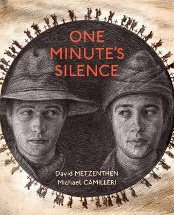One Minute's Silence by David Metzenthen

Ill. by Michael Camilleri. Allen & Unwin, 2014. ISBN
9781743316245
(Age: Yr 5+) One minute's silence is the traditional way of
honouring the memory of those who have died, particularly military
personnel. And during that one minute's silence, we are urged to
think about those who have fallen and the sacrifice they have made
for their country. But what do you really think about? Are you like
the bored, disinterested Year 12 students who open this story? Do
you think about the feats and fears of our soldiers and what they
did? Do you ever think about what it was like for those on the other
side of our bullets and bayonets? For, in this powerful picture
book, we are encouraged to do just that, to consider what it was
like both for those who made that fateful landing on the shores of
Gallipoli in 1915 and those whom they were fighting against.
'In one minute's silence you can imagine the grinding in your guts
as the ironbark bows of the Australian boats bumped the stony shore
of Gallipoli on the twenty-fifth of April 1915, when twelve thousand
wild colonial boys dashed across the shivering Turkish sand in the
pale light of a dairy farmer's dawn lashed with flying lead. But can
you imagine, in one minute's silence, lines of young Turkish
soldiers from distant villages, hearts hammering, standing
shoulder-to-shoulder in trenches cut like wounds.firing on strangers
wading through the shallows intent on streaming into the homeland of
the Turkish people.'
This remarkable retelling of the events that will form the focus of
the centennial commemorations in 1915 starts with a picture of that
group of senior students who have been asked to observe one minute's
silence on the 11th hour of the 11th day of the 11th month -
Remembrance Day in Australia. Their expressions of
here-we-go-again-we've-been-doing-this-for years have been captured
perfectly in the pencil strokes of Michael Camilleri and one might
wonder what this book has to offer that has not been done before.
But then the narration begins and as the events unfold the students
are drawn into them, gradually realising the youth and ordinariness
of those who were embroiled in this conflict 100 years ago. These
were kids just like them. They can put themselves in the picture, as
Camilleri has. However, not only do they see themselves in the
Australian uniform, but their attention is also drawn to the youth
and the ordinariness of those on the other side and their
perspective. They are no longer just a faceless enemy responsible
for the deaths and maiming of these students' bygone family members.
The futility of war is apparent.
Barbara Braxton